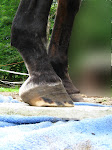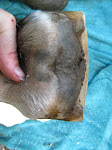To better compare photos, open a second window and fit it to the bottom half of the screen. Click any photo to enlarge.
Cooter died June 2009. Fortunately it was quick. One minute he was Mr. Sexy, and 3 minutes later, gone. The vet suspects an aneurysm.
Cooter's feet were far from perfect at the time of his death. However, I am proud to say, he was comfortable enough for 15 solid minutes of non-stop, mosh pit high acrobatics, after his first spring bath. I saw courbettes, caprioles, levades, rear-buck combos and a bunch of athletic stuff I don't have names for - stuff I'd never seen out of this horse before. He was always above average athletic, but this was a step above his shod, fit, self. It seems, at the time of his death, his feet were not only providing him with comfort, but also improved performance.
I also saw improved straightness. When comparing a 2002 video to a 2009 video, I saw medial hind discomfort in the 2002 video. Which means, he was showing medial hind discomfort, even when shod. His hocks would skew outward when loaded, kinematics, I now recognize, as a possible indicator of medial hoof discomfort. In 2009, once the medial hind hoof was more comfortable, the hinds loaded almost perfectly straight, no more skewing hocks.
I have posted Cooter's freeze dryed feet so we can all learn. All the feet are educational in an of themselves, but when all four feet are considered together, the realizations are stunning.
Cooter's transition started Nov 07, with minimal "top down" trimming only - managing only flare. There was some pain in the beginning for him, but all went unremarkably well through the first winter. However, in Apr 08, feeling like I wasn't "doing enough", I started trimming to Strasser methods. I now know, my success would have continued, and much pain would have been avoided, had I continued "top down" trimming. But that's not what happened.
Just a week after his first Strasser-type trimming, I came home to find the horse leaning against the wall to support himself, not wanting to weight his RH foot. I suspect he just stepped on something. But with not enough foot left after the "Strasser" trimming, he badly bruised his foot. This was the beginning of the struggle. Pictures start May 08.
After that, figuring out which experts to listen to took a while. Two stood out, Pete Ramey was one, Cooter was the other.

23 Jun 09:

To me, this is the most stunning foot. In this photo the concavity of the foot is sucks. None of the feet have enough sole, but in this foot there is only a 1/4" of sole between his coffin bone and the outdoors. Lack of groove depth around the frog, lack of concavity and a bruise on the sole indicated the severity of the condition. I opted to give it time, rather than put equi-casts on. I made this decision only in light of my health. Ideally, equi-casts would have gone on this foot before the appearance of the bruise, just based on sole concavity and lack of groove depth. This foot is scary far from perfect. He was ouchy on this foot the last two months of his life - jiggering if he stepped on a 1/2" rock.
The most interesting revelation I took from seeing this sectioned foot was: The equi-casts are amazing at developing sole fast. Had this foot been cast at the same time as the rears, I likely would have had the same sole concavity and sole thickness as the rears, at least. To me, this shows, ideally, you should cast all 4 feet. Why? All 4 feet work together as a system. I believe part of the reason he had so little sole under this bone was because the bone rotated dramatically once comfort in the rear was achieved. About the time I took the equi-casts off the back feet, a red impression of the foot bone revealed itself on this RF sole, and he became ouchy on that foot. One day he wasn't ouchy and the sole clear, the next he was ouchy with an evident sole bruise. I decided to not do anything about the problem and give it a month or two to see if it would adjust itself. I think the rotation occurred in hours - not what we usually think can happen unless there is swelling involved.
Arrows: Red: Original callous (moonsicle) 2 months prior to death. Blue: Site where new callous needed. Green: New emergency callous forming and progressing to new site (blue arrow).

After trim 17 Aug 08:
Before trim 17 Aug 08:
After trim 9 Aug 08:
Before trim 9 Aug 08:

After trim 26 Jul 08:
Before trim 26 Jul 08:
After trim 19 Jul 08:
Before trim 19 Jul 08:
After trim 12 Jul 08:
| ---------------------- Oops forgot pics -------------------- |
 |
 |
 |
 |
Before trim 12 Jul 08:
 To me, this is the most stunning foot. In this photo the concavity of the foot is sucks. None of the feet have enough sole, but in this foot there is only a 1/4" of sole between his coffin bone and the outdoors. Lack of groove depth around the frog, lack of concavity and a bruise on the sole indicated the severity of the condition. I opted to give it time, rather than put equi-casts on. I made this decision only in light of my health. Ideally, equi-casts would have gone on this foot before the appearance of the bruise, just based on sole concavity and lack of groove depth. This foot is scary far from perfect. He was ouchy on this foot the last two months of his life - jiggering if he stepped on a 1/2" rock.
To me, this is the most stunning foot. In this photo the concavity of the foot is sucks. None of the feet have enough sole, but in this foot there is only a 1/4" of sole between his coffin bone and the outdoors. Lack of groove depth around the frog, lack of concavity and a bruise on the sole indicated the severity of the condition. I opted to give it time, rather than put equi-casts on. I made this decision only in light of my health. Ideally, equi-casts would have gone on this foot before the appearance of the bruise, just based on sole concavity and lack of groove depth. This foot is scary far from perfect. He was ouchy on this foot the last two months of his life - jiggering if he stepped on a 1/2" rock.






















































